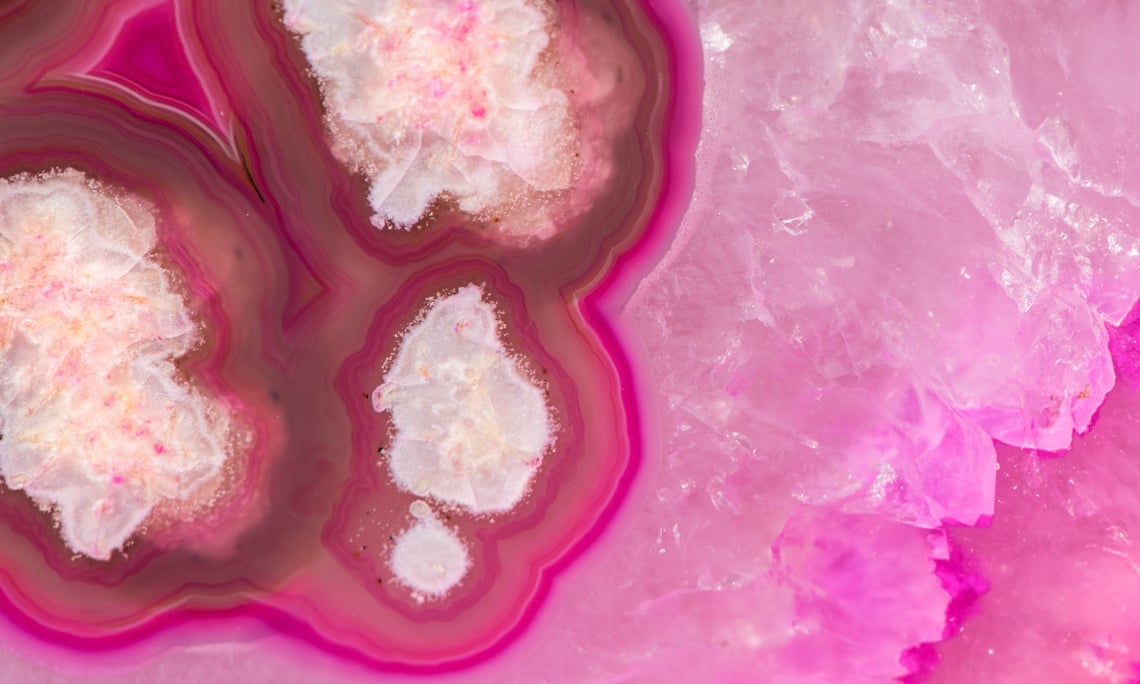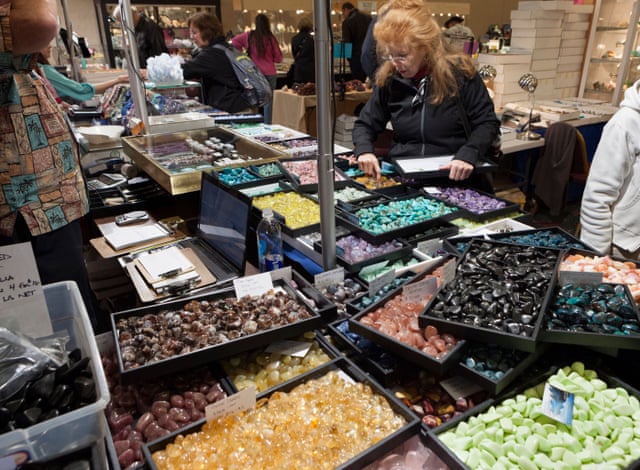- UID
- 20
- Online time
- Hours
- Posts
- Reg time
- 24-8-2017
- Last login
- 1-1-1970
|
|
━━━━━━━━━━━━━━━━━
Demand for ‘healing’ crystals is soaring – but many are mined in deadly conditions in one of the world’s poorest countries. And there is little evidence that this billion-dollar industry is cleaning up its act.

Main image: Photograph: John Lawson/Getty
▼ In February, crystals colonised Tucson. They spread out over carparks and gravel lots, motel courtyards and freeway footpaths, past strip malls and burger bars. Beneath tents and canopies, on block after block, rested every kind of stone imaginable: the opaque, soapy pastels of angeline; dark, mossy-toned epidote; tourmaline streaked with red and green. There were enormous, dining-table-sized pieces selling for tens of thousands of dollars, lumps of rose quartz for $100, crystal eggs for $1.50. Crystals were stacked upon crystals, filling plastic trays, carved into every possible shape: knives, penises, bathtubs, angels, birds of paradise.
It was the month of the Tucson gem shows, a series of markets and exhibitions that collectively make up the largest crystal expo in the world. More than 4,000 crystal, mineral and gemstone vendors had come to sell their wares. They were expecting more than 50,000 customers to pass through, from new age enthusiasts with thick dreadlocks and tie-dye T-shirts, to gallery owners, suited businessmen and major wholesalers. Deals done here would determine the fate of tens of thousands of tonnes of crystals, dispatching them across the US and Europe into museums and galleries, crystal healing and yoga centres, wellness retailers and Etsy stores.
Five years ago, crystals were not a big deal. Now, powered by the lucrative combination of social media-friendly aesthetics, cosmic spirituality and the apparently unstoppable wellness juggernaut, they have gone from a niche oddity associated with patchouli and crushed velvet to a global consumer phenomenon. On Instagram, hashtags for #crystals and #healingcrystals tick into the tens of millions. In 2017, the New York Times heralded “the great crystal boom” and in 2018 Hello! described them as the year’s biggest health and wellness trend. Sold as lamps, sex toys, facial massagers or “vaginal eggs” hawked by Gwyneth Paltrow’s lifestyle empire Goop, there is now a crystal for every possible occasion. As Kim Kardashian was recovering from her robbery at gunpoint in 2016, she embraced healing crystals. The model Miranda Kerr has said that she filters all her skincare products through rose quartz “to give the vibration of self-love”.

The Gem and Mineral Show in Tucson, Arizona in 2014. Photograph: BAE Inc/Alamy
In the US, demand for overseas crystals and gemstones has doubled over the past three years, and quartz imports have doubled since 2014. (Those numbers capture raw stone, but not the crystals imported under many other categories: jewellery, home goods, decorations.) Daniel Trinchillo, owner of Fine Minerals International, a high-end crystal dealership, told me that his business makes between $30m and $40m in sales each year. Trinchillo caters to a growing cohort of celebrities, collectors and investment buyers who want rare and valuable crystals. The most expensive single piece he has sold went for $6m, but he knows of some that have sold for $10m. Trinchillo estimates that high-end dealers now account for about $500m in annual sales. Include the lower end, he said, and you are talking about a highly profitable, multi-billion dollar industry.
Believers say crystals conduct ambient energy – like miniature phone towers picking up signals and channelling them on to the user – thus rebalancing malign energies, healing the body and mind. First popularised in the west in the 1970s, crystal healing’s recent resurgence has coincided with growing interest in alternative spirituality and healing practices. According to Pew Research Centerdata, more than 60% of US adults hold at least one “new age” belief, such as placing faith in astrology or the power of psychics, and 42% think spiritual energy can be located in physical objects such as crystals. Not surprisingly, then, scientific criticism of crystal healing has done little to dim demand. Last year, Paltrow faced ( and settled) a misleading advertising lawsuit for claiming that Goop’s vaginal egg crystals had the power to balance hormones and regulate menstrual cycles. But still, the rise of crystals continues.
Despite that explosive growth, the way the crystal industry operates has largely avoided close scrutiny. There is little in the way of fair-trade certification for crystals, and none of the industry-wide transparency schemes developed for commodities such as gold and diamonds. Tracing a crystal from the time it is dragged, dusty and cracked, from the earth, to the polished moment of final sale requires a journey backward down the supply chain: from shop, to exporter, to middleman, to mine, and finally to the men and women who work below the ground, on whose labour a billion-dollar industry has been built.
Madagascar is one of the poorest countries in the world, but (▪ ▪ ▪)
► Please, continue reading this article here: Source |
|